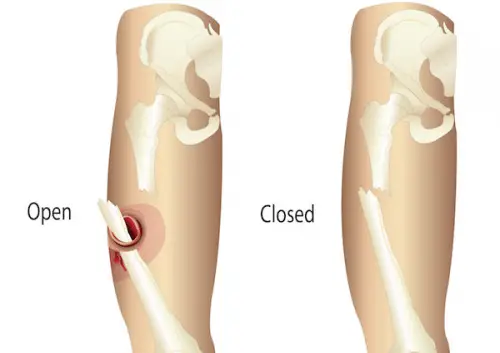Both open and closed fractures require immediate medical attention.
Since they greatly differ in a number of ways, learning to distinguish between the two is critical in developing an appropriate health care plan.
Summary Table
| Open Fracture | Closed Fracture |
| Also called a compound fracture | Also called a simple fracture |
| Manifested by a break in the skin | Manifested by skin swelling, bruising, and a bone deformity |
| Puts the patient at risk for infection | Does not put the patient at risk for infection |
| Treatment options include debridement and irrigation, antibiotic prescriptions, skin grafts, free flap, local flap, internal fixation, and external fixation | Treatment options include cast immobilization, internal fixation, and external fixation |
| Longer healing time | Shorter healing time |
What is a Fracture?
The word “fracture” is the medical term for a broken bone. Fractures are quite common, with each person having at least two fractures during their lifetime. Broken bones can occur when the physical force put on a bone is stronger than the bone itself.
The risk of developing a fracture depends on your age. Broken bones are common all during childhood, those kids’ fractures are usually not as complicated as they are in adults. However, as we age, our bones become more brittle, making fractures more likely.
There are many types of fractures, including open and closed fractures.
What are the Symptoms of a Bone Fracture?
Fractures come in different types, but no matter what, they cause injuries to a person’s skeleton.
It’s also possible for one person to have more than one type of fracture.
If you have a broken bone, you may have these symptoms:
- Intense pain
- Swelling
- Bruising
- Deformity
- Inability to use the limb/limited mobility
- Broken skin with bone protruding
- Numbness and tingling
- Bleeding
What to Do If You Have an Open or Closed Bone Fracture?
The first aid for either type of fracture is as follows:
- Don’t move the person, unless it’s necessary to avoid additional injury.
- Stop any bleeding
- Immobilize the injured area
- Apply ice packs to limit swelling and help relieve pain
- Treat the person for shock
- Call emergency services
If the person is conscious and able to walk, you can take them to the emergency room at the nearest hospital for treatment ASAP.
Definitions

An open fracture, commonly referred to as a compound fracture, is a type of fracture characterized by an open wound on the skin that overlays a broken bone.
Meanwhile, a closed fracture, also known as a simple fracture, is a type of fracture where the broken bone does not protrude out of the skin.
Open vs Closed Fracture
Both may be characterized by a break in the bone, but there is still a huge difference between an open and a closed fracture.
Terminology
An open fracture is known as a compound fracture, while a closed fractured is commonly called a simple fracture.
Clinical Manifestations
An open fracture involves a break in the skin, which is caused by the protrusion of a broken bone. In severe cases, the internal tissues and the bone can also be exposed, depending on the impact of the incident that caused the injury.
A closed fracture, by contrast, does not cause any skin breakage. However, visible signs like skin swelling, bruising and a bone deformity are typically present near the fractured bone.
Risk for Infection
Unlike a closed fracture, an open fracture puts the patient at risk for infection because of the presence of an open wound, which can be a pathway for dirt, bacteria, and other contaminants.
Treatment
Both open and closed fractures may require internal fixation or external fixation. Internal fixation realigns the bones by the use of metal implants, while external fixation immobilizes and heals the bones with the help of metal pins and screws. Despite their similarity, there are still significant differences in how the two are treated, depending on the severity of the injury.
The primary goal behind the treatment of an open fracture is to prevent infection and to realign the bones. Infection control involves debridement and irrigation, which is performed to remove all possible contaminants that entered the open wound. The health care plan for an open fracture also includes the use of antibiotics. More complex types of open fractures that are characterized by severe tissue and skin loss may also require skin and tissue transplants such as skin grafts, free flap, and local flap.
A closed fracture, by comparison, does not require any of these measures. While internal fixation or external fixation is a critical treatment plan for severe closed fractures, simpler cases can be treated by cast immobilization, which promotes bone healing and realignment.
Recovery
The recovery period of open closed fractures greatly depends on the severity of the fracture. However, between the two, an open fracture is slower to heal since it involves the tissue and the skin. Typically, a closed fracture can be treated in four weeks or more, while an open fracture takes months to recover.





